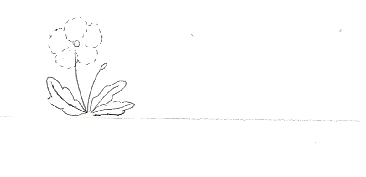
| Requirements: Stranded cottons in your choice of Green, Pale yellow, and white 2 x 35cm (14") lengths of 30-gauge white cake decorators' wire The background fabric and calico as you used for your Buttercup An extra piece of calico for working the petals |
| Other requirements as for Buttercup |
 |
| I am assuming that you have already worked your Buttercup, so draw or trace the pattern for the Nodding Lily in the position shown, omitting the dotted lines, and mount your fabric in the larger hoop, making sure the fabric is taut. Using green work the stems in Stem stitch. Work a row of Stem stitch to outline the leaves, and fill in the leaves with rows of close Stem Stitch so that no fabric shows through the stitching. |
| Now mount the smaller piece of calico in the smaller hoop. Cut each length of wire into 4 pieces. Shape one of these short lengths to the shape shown on the pattern.The Buttercup petals were round, those of the Lily are more of an oval shape. Using oner strand of White thread attach one shaped wire to the calico with 3-4 holding stitches. Still using the white thread, buttonhole over the wire, through the calico, keeping your stitches close to the wire and completely covering it. When you have worked right round the petal in this way, fill in the petal with vertical satin stitch, still using one strand of white thread. Work 8 petals in this way. When all the petals have been worked, cut carefully around each petal, as closely as you can to the stitching. Run the back of your scissors along the cut edge and trim off any little 'whiskers'. |
| In the same way as you attached the Buttercup petals, by sliding the two wires from one petal down beside the eye of the knitter's needle, attach 3 petals at the end of each curved stem so that the petals turn up as shown.. Turn the work over and take one wire from each of two petals. Attach to the calico backing as you did the Buttercup. Just below the 3 petals work 3-4 bullion stitches using two strands of Pale Yellow thread, coming to a point at the bottom where you will work a French knot with the same thread. At the top of the longest stem attach the remaining two petals as shown, then using 2 strands of green work detached chain stitches to represent the sepals at the back of the flower. Your garden bed should now look something like this: |
 |
| Thank you for your interest in these free patterns. If you have any problems please e-mail me at rjfletch@iaa.com.au |
| Top of Page |
| BACK HOME NEXT |
